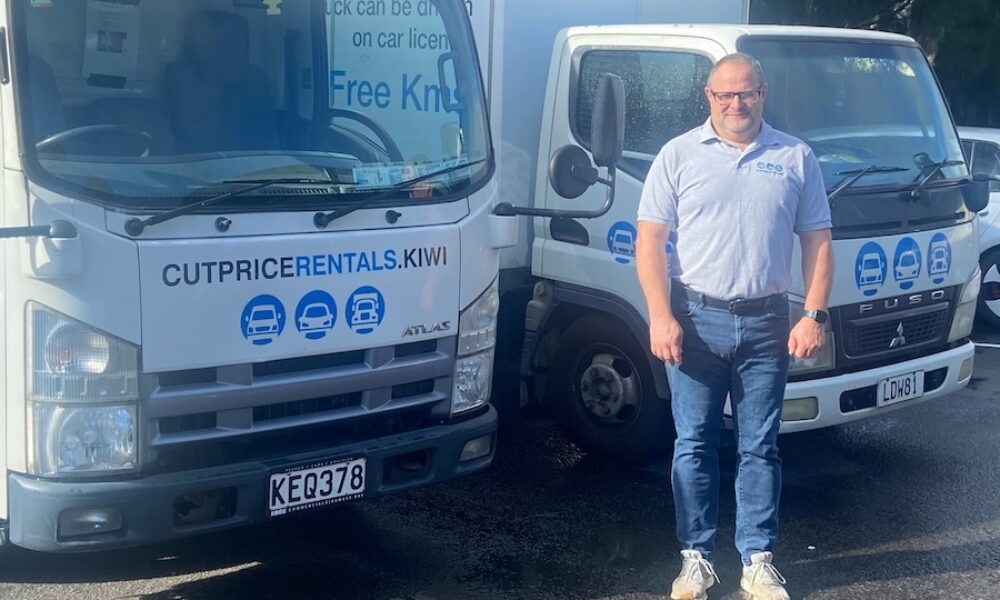Walk the customer walk
Pictured above: Cam Rock at his Cut Price Rentals business in New Plymouth.
Business lecturers Dr. Steve Scott and Cam Rock take a rather humorous look at the challenge of customer service, and offer up practical improvements small businesses owners can make.
On a warm and sunny May morning my home appliances unexpectedly formed a Death Cult and conspired against me. Not the reliable and dependable ones, like the toaster and the kettle, not the good ones, but those large rectangular white ones, the ones that are difficult to move once they have claimed a space. First it was the fridge-freezer, the king of the icy cool. This behemoth decided on a whim that he now identified as an old-school fan heater. Not cool. Not cool at all. Then it was the clothes dryer, his short statured cousin. This rotund windbag decided to go out in sympathy for the King of the Kitchen, taking over his role entirely, and produced nothing but cold air. And finally, it was the washing machine’s turn. This agitator cycled onto a newly invented setting, Dirtier Mode, making dirty clothes even more filthy.
“Fix them,” my wife said, handing me a screwdriver, assuming my knowledge of cars somehow extended to home appliances.
I fondled the screwdriver uncomfortably and called the bank. Perhaps, I thought, they could save me. And even though my call was important to them, apparently, the expected waiting time was a date in late July. The year was uncertain and not stated audibly. Fumbling through their website looking for another form of contact, a helpful figure popped up in the corner of my screen prompting me to send them a secure message via their app. “Dear Bank, I would like to request a short-term overdraft to replace some household appliances that have committed Seppuku. I am expecting some funds in early September, so will be able to clear it for you then.”
Two days later I received a call.
“Do you still own your car rental business,” she asked, without preamble.
“Yes.”
“I thought so,” she seemed relieved. “You’ll need to speak to a Grade 5 Banker. I’m only Grade 4. I don’t deal with corporate finance.”
“But this is not a business-related expense,” I told her. “This is a whiteware rebellion. My milk is warm. I’m running out of clean underwear. My wife keeps handing me strange tools I don’t know the name of, let alone how to use.”
“You’ll get a call from a Grade 5,” she said, not listening to my maintenance induced anxiety, and was gone before I could waste anymore of her time.
Two days later there were three messages on my phone, each one becoming slightly more hostile than the last.
Call one: “I will call again in ten minutes,” The Grade 5 said. “Please make sure your wife is also with you. We will need a list of expenses. I see you buy pet food and lotto tickets. Hmmmm.”
I was at work. My wife was at work. This call came in three hours ago.
Call two: “You are still not answering,” the robotic voice told me. “I see that you and your wife each bought cappuccinos and some sort of baked bread products this morning. We will need to review this behaviour when I get in contact with you.”
Call three: “Why are you ignoring my call?” the angry Grade 5 asked. “I am very busy and have other more important people to deal with. Please contact the call centre if you still wish to pursue this overdraft.”
I was trapped. I couldn’t call her back directly because she hadn’t left her number. I couldn’t email her because she didn’t supply her details. I was forced to phone the contact centre, again. And I was scared to buy any more cappuccinos, which had me on edge from a lack of caffeine. Or, I mused, I could fix this myself. I picked up the screwdriver and looked at it sadly. The pets wouldn’t catch my eye. The fridge shuddered its dissatisfaction.
On Saturday at our kids hockey practice I complained to my friend Steve, who has a PhD in business and lectures locally, about my appliance maintenance misadventures and my brief trip to the bizarre world of banking purgatory.
Dr. Steve, who is not known for his empathy, pulled a face, frowned, and challenged me, “So you’re a business owner. You’ve just had a bad customer service experience. Are you sure your business is that much better? When was the last time you were a customer for your own services?”
Even though I was annoyed at his lack of empathy for my plight, it did make me pause – do I make one of the most common errors business owner’s make? Do I become so caught up working in the business, that I forget the importance of understanding how the business operates?
“Businesses, like banks and your rental business, should always be looking at ways to provide their customer with better service,” he stated, “lower costs and reduce wasteful activities. These are the general principles of LEAN management and there is value in the principles of the program for every business.”
Now I knew that LEAN Management is based on the Toyota Production System (TPS). “The objective is to thoroughly eliminate waste and shorten lead times to deliver vehicles to customers quickly, at a low cost, and with high quality.” But what I didn’t know is that I could use these principles for my small business or how to even do it.
Simple he said, “Start by doing these simple steps of walking the customers walk through your business”:
- Do your research: Look at not only your own, but your competitors’ websites, advertising programs and social media accounts.
- Buy or Book: Go through the process of buying your own service or product and your competitors. For even better objectivity, get a friend to do it.
- Fail the Customer: Go through the cancellation, rebooking, return or refund process.
- Use It: Where feasible, actually use the service or product as if you were a customer. Be honest about what you like and don’t like about it and if having a friend do it be open to their feedback.
- Follow Up: Review the follow up process. Is it a call, email, or text. If so, does it create value for the customer.

Once you have done the walk, then really start to look at what you do and whether it actually adds value to the customer experience or to your business’s bottom line:
- Don’t Be Defensive: If you have a friend going through the process, don’t be defensive with their feedback. Be objective and don’t argue with them about what they experience. You can choose not to make change, but what they experience was real to them and is likely similar for your other customers.
- Look for Value: At every step, ask yourself: did this add value for the customer or for the business. If the answer is no, or even questionable, then look hard at these processes or products.
- Remove Waste: Look for processes or products that create waste and get rid of them. Are you wasting your customer’s time making them fill out info you don’t need or even use anymore? Are you making customers call different departments to get answers when the first person had the info, wasting the time of your people and the customers.
- Remove Roadblocks: Identify and remove processes that stop systems or people from helping your customers. Is there a requirement on your website that stops a customer from buying because you “want” info versus needing info? Are your internal processes so rigid that staff can’t help a customer for fear of the system?
“Did you fix your washing machine or you wearing your underwear inside out?” he asked randomly as a concluding comment.
“Never mind I don’t want to know.”
About the authors:
Dr. Steve Scott is a Business Lecturer at the Western Institute of Technology in Taranaki (WITT).
Cam Rock is owner of Cut Price Rentals in New Plymouth and a Business Lecturer at the Western Institute of Technology in Taranaki (WITT).







